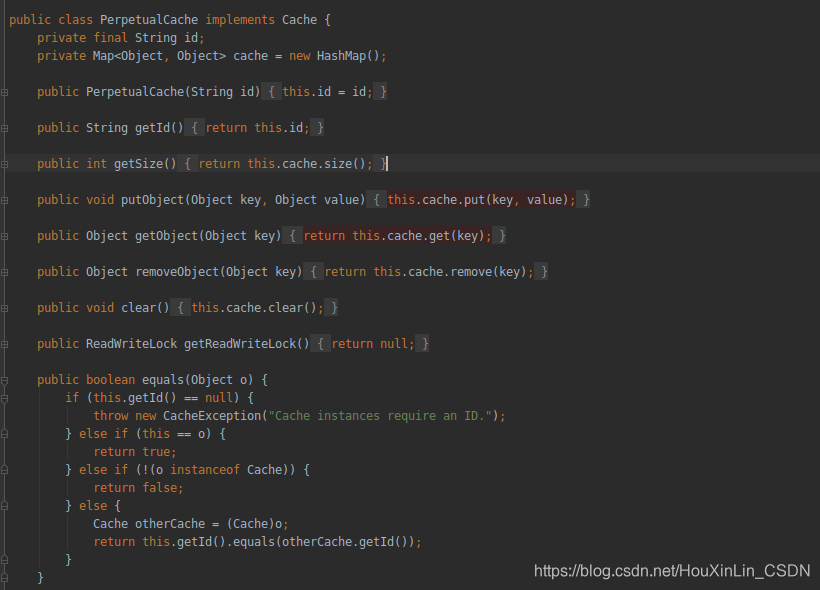带你了解MyBatis一二级缓存
Posted 听风逝夜blog
tags:
篇首语:本文由小常识网(cha138.com)小编为大家整理,主要介绍了带你了解MyBatis一二级缓存相关的知识,希望对你有一定的参考价值。
在对数据库进行噼里啪啦的查询时,可能存在多次使用相同的SQL语句去查询数据库,并且结果可能还一样,这时,如果不采取一些措施,每次都从数据库查询,会造成一定资源的浪费,所以Mybatis中提供了一级缓存和二级缓存来解决这个问题,通过把第一次查询的结果保存在内存中,如果下次有同样的语句,则直接从内存中返回。
一级缓存
一级缓存的作用域在同一个SqlSession,也就是说两个一样的SQL语句,第一次会从数据库中获得,并保存在一个Map<Object, Object> 中,第二次会从这个Map中返回,Mybatis默认开启了一级缓存。
下面是代码演示
public static void main( String[] args )
{
String resource = "mybatis-config.xml";
try {
InputStream inputStream = Resources.getResourceAsStream(resource);
SqlSessionFactory build = new SqlSessionFactoryBuilder().build(inputStream);
SqlSession sqlSession = build.openSession();
System.out.println(sqlSession.getMapper(IUserDao.class).select());
System.out.println(sqlSession.getMapper(IUserDao.class).select());
} catch (IOException e) {
e.printStackTrace();
}
}在配置文件中加入日志实现类来打印执行日志
<settings>
<setting name="logImpl" value="STDOUT_LOGGING" />
</settings>通过日志可以发现,在第一次查询时构造了sql语句,从数据库查询,第二次并没有构造sql,直接返回了缓存的数据。
Opening JDBC Connection
Created connection 1928931046.
Setting autocommit to false on JDBC Connection [com.mysql.cj.jdbc.ConnectionImpl@72f926e6]
==> Preparing: select * from tb_user
==> Parameters:
<== Columns: user_tel, user_name, user_passwd
<== Row: 1500, 123, 111
<== Row: 1501, 123, 222
<== Total: 2
[UserEntity{userTel='1500', userName='123', userPass='111'}, UserEntity{userTel='1501', userName='123', userPass='222'}]
[UserEntity{userTel='1500', userName='123', userPass='111'}, UserEntity{userTel='1501', userName='123', userPass='222'}]
一级缓存源码分析
在BaseExecutor中有一个PerpetualCache类,而PerpetualCache很简单,其中Map<Object, Object>则是用来保存缓存


那就先可以假设,保存缓存时一定会调用其putObject方法,而取出缓存时一定调用getObject方法,通过debug可以看到,在第一次查询完成之后,会调用putObject方法,key为sql语句,value是结果.

调用putObject方法在BaseExecutor下的queryFromDatabase中
private <E> List<E> queryFromDatabase(MappedStatement ms, Object parameter, RowBounds rowBounds, ResultHandler resultHandler, CacheKey key, BoundSql boundSql) throws SQLException {
//先占位?
this.localCache.putObject(key, ExecutionPlaceholder.EXECUTION_PLACEHOLDER);
List list;
try {
//从数据库查询
list = this.doQuery(ms, parameter, rowBounds, resultHandler, boundSql);
} finally {
this.localCache.removeObject(key);
}
//吧结果保存在PerpetualCache中
this.localCache.putObject(key, list);
if (ms.getStatementType() == StatementType.CALLABLE) {
this.localOutputParameterCache.putObject(key, parameter);
}
return list;
}而调用queryFromDatabase在query中,首先判断缓存中有没有数据,没有则调用queryFromDatabase从数据库查找,有就直接返回
List list;
try {
++this.queryStack;
//从缓存中获取
list = resultHandler == null ? (List)this.localCache.getObject(key) : null;
if (list != null) {
this.handleLocallyCachedOutputParameters(ms, key, parameter, boundSql);
} else {
//从数据库获取
list = this.queryFromDatabase(ms, parameter, rowBounds, resultHandler, key, boundSql);
}
} finally {
--this.queryStack;
}手动清除缓存
SqlSession提供了clearCache来清除缓存,当第一次查询玩之后,手动清除缓存,就会发现第二次也是从数据库中查找,原理也就是对PerpetualCache进行了clear();
public static void main( String[] args )
{
String resource = "mybatis-config.xml";
try {
InputStream inputStream = Resources.getResourceAsStream(resource);
SqlSessionFactory build = new SqlSessionFactoryBuilder().build(inputStream);
SqlSession sqlSession = build.openSession();
System.out.println(sqlSession.getMapper(IUserDao.class).select());
sqlSession.clearCache();
System.out.println(sqlSession.getMapper(IUserDao.class).select());
} catch (IOException e) {
e.printStackTrace();
}
}Opening JDBC Connection
Created connection 1928931046.
Setting autocommit to false on JDBC Connection [com.mysql.cj.jdbc.ConnectionImpl@72f926e6]
==> Preparing: select * from tb_user
==> Parameters:
<== Columns: user_tel, user_name, user_passwd
<== Row: 1500, 123, 111
<== Row: 1501, 123, 222
<== Total: 2
[UserEntity{userTel='1500', userName='123', userPass='111'}, UserEntity{userTel='1501', userName='123', userPass='222'}]
==> Preparing: select * from tb_user
==> Parameters:
<== Columns: user_tel, user_name, user_passwd
<== Row: 1500, 123, 111
<== Row: 1501, 123, 222
<== Total: 2
[UserEntity{userTel='1500', userName='123', userPass='111'}, UserEntity{userTel='1501', userName='123', userPass='222'}]并且Mybatis会在Insert、Update后都会自动删除缓存
但是会有一个数据不一致的问题,很多人称之为坑,举个数据不一致的例子,两个SqlSession,都保存了id为1500的数据,但是当SqlSession1更新了1500的密码后,SqlSession2在获取并没有从数据库获取,而是从缓存中获取,缓存中的是旧密码,就出现缓存不一直问题
public static void main( String[] args )
{
String resource = "mybatis-config.xml";
try {
InputStream inputStream = Resources.getResourceAsStream(resource);
SqlSessionFactory build = new SqlSessionFactoryBuilder().build(inputStream);
SqlSession sqlSession1 = build.openSession(true);
SqlSession sqlSession2 = build.openSession(true);
sqlSession1.getMapper(IUserDao.class).selectByTel("1500");
sqlSession2.getMapper(IUserDao.class).selectByTel("1500");
System.out.println("1500的密码---"+sqlSession2.getMapper(IUserDao.class).selectByTel("1500").getUserPass());
sqlSession1.getMapper(IUserDao.class).upUserPass("1500","456");
System.out.println("----"+sqlSession2.getMapper(IUserDao.class).selectByTel("1500"));
} catch (IOException e) {
e.printStackTrace();
}
}Cache Hit Ratio [com.hxl.dao.IUserDao]: 0.0
Opening JDBC Connection
Created connection 1780034814.
==> Preparing: select * from tb_user where user_tel=?
==> Parameters: 1500(String)
<== Columns: user_tel, user_name, user_passwd
<== Row: 1500, 123, 123
<== Total: 1
Cache Hit Ratio [com.hxl.dao.IUserDao]: 0.0
Opening JDBC Connection
Created connection 918312414.
==> Preparing: select * from tb_user where user_tel=?
==> Parameters: 1500(String)
<== Columns: user_tel, user_name, user_passwd
<== Row: 1500, 123, 123
<== Total: 1
Cache Hit Ratio [com.hxl.dao.IUserDao]: 0.0
1500的密码---123
==> Preparing: UPDATE tb_user set user_passwd=? where user_tel=?
==> Parameters: 456(String), 1500(String)
<== Updates: 1
Cache Hit Ratio [com.hxl.dao.IUserDao]: 0.0
----UserEntity{userTel='1500', userName='123', userPass='123'}
解决办法在配置文件中加入<setting name="localCacheScope" value="STATEMENT"/>,原理是在BaseExecutor#query中判断了LocalCacheScope是不是等于STATEMENT,如果等于,则清除缓存,这就意味着每次查询完都清除缓存,间接的表示关闭了一级缓存
if (this.configuration.getLocalCacheScope() == LocalCacheScope.STATEMENT) {
this.clearLocalCache();
}二级缓存
二级缓存作用于是Mapper中的namespace,脱离了SqlSession,二级缓存的总开个默认也是开启的,也就是很多人说在配置文件中加入<setting name="cacheEnabled" value="true"/>,脱裤子放屁,简直多此一举

既然有主开关了,那就还有个次开关,其实还有个次次开关,次开关就是在mapper文件中加入<cache></cache>,即表示开启二级缓存

下面代码先演示
public static void main( String[] args )
{
String resource = "mybatis-config.xml";
try {
InputStream inputStream = Resources.getResourceAsStream(resource);
SqlSessionFactory build = new SqlSessionFactoryBuilder().build(inputStream);
SqlSession sqlSession1 = build.openSession();
SqlSession sqlSession2 = build.openSession();
System.out.println(sqlSession1.getMapper(IUserDao.class).selectByTel("1500"));
//提交
sqlSession1.commit();
System.out.println(sqlSession2.getMapper(IUserDao.class).selectByTel("1500"));
} catch (IOException e) {
e.printStackTrace();
}
}Cache Hit Ratio [com.hxl.dao.IUserDao]: 0.0
Opening JDBC Connection
Created connection 1780034814.
Setting autocommit to false on JDBC Connection [com.mysql.cj.jdbc.ConnectionImpl@6a192cfe]
==> Preparing: select * from tb_user where user_tel=?
==> Parameters: 1500(String)
<== Columns: user_tel, user_name, user_passwd
<== Row: 1500, 123, 789
<== Total: 1
UserEntity{userTel='1500', userName='123', userPass='789'}
Cache Hit Ratio [com.hxl.dao.IUserDao]: 0.5
UserEntity{userTel='1500', userName='123', userPass='789'}
Process finished with exit code 0
当第一次查询时,命中率为0.0(Cache Hit Ratio [com.hxl.dao.IUserDao]: 0.0),第二次为0.5(Cache Hit Ratio [com.hxl.dao.IUserDao]: 0.5),所以从缓存中获取,但是如果吧其中 sqlSession1.commit();去掉,就发现两次都从数据库查找,命中率都为0.0,原因是二级缓存有一个TransactionalCacheManager来管理二级缓存,只有调用其commit()方法才会真正保存下来,在调用SqlSession的close或者commit方法时都会调用到CachingExecutor下的close和commit方法,这两个方法对缓存进行真正的提交。


二级缓存源码分析
在Configuration的newExecutor中判断了总开关是否打开,如果打开,则使用CachingExecutor
public Executor newExecutor(Transaction transaction, ExecutorType executorType) {
executorType = executorType == null ? this.defaultExecutorType : executorType;
executorType = executorType == null ? ExecutorType.SIMPLE : executorType;
Object executor;
if (ExecutorType.BATCH == executorType) {
executor = new BatchExecutor(this, transaction);
} else if (ExecutorType.REUSE == executorType) {
executor = new ReuseExecutor(this, transaction);
} else {
executor = new SimpleExecutor(this, transaction);
}
//判断总开关是否打开
if (this.cacheEnabled) {
executor = new CachingExecutor((Executor)executor);
}
Executor executor = (Executor)this.interceptorChain.pluginAll(executor);
return executor;
}查询时最终调用到在CachingExecutor的query方法,首先从MappedStatement中获取Cache,如果在Mapper文件中没有配置Cache标签,它会返回空,直接从数据库查询,如果配置了,还要判断标签上的useCache属性是不是为true,也就是刚才说的次次开关,可以增加useCache=“false”来关闭这个select的缓存。
然后从缓存事物管理器中获取缓存,没有的话从数据库查询,并且添加结果到缓存事物管理器,有就返回。

public <E> List<E> query(MappedStatement ms, Object parameterObject, RowBounds rowBounds, ResultHandler resultHandler, CacheKey key, BoundSql boundSql) throws SQLException {
Cache cache = ms.getCache();
if (cache != null) {
//判断是否刷新缓存
this.flushCacheIfRequired(ms);
//标签上是的useCache属性是否为true
if (ms.isUseCache() && resultHandler == null) {
this.ensureNoOutParams(ms, boundSql);
//从缓存中获取
List<E> list = (List)this.tcm.getObject(cache, key);
if (list == null) {
list = this.delegate.query(ms, parameterObject, rowBounds, resultHandler, key, boundSql);
//添加到缓存
this.tcm.putObject(cache, key, list);
}
return list;
}
}
return this.delegate.query(ms, parameterObject, rowBounds, resultHandler, key, boundSql);
}cache配置
cache有几个属性值
- 一 eviction:缓存回收策略,默认是LRU
LRU(Least Recently Used),最近最少使用的,最长时间不用的对象
FIFO(First In First Out),先进先出,按对象进入缓存的顺序来移除他们
SOFT,软引用,移除基于垃圾回收器状态和软引用规则的对象
- WEAK,弱引用,更积极的移除基于垃圾收集器状态和弱引用规则的对象
- flushInterval:刷新间隔,单位为毫秒
- size:缓存中的个数
- readOnly:是否只读
- type:自定义缓存
- blocking:是否阻塞
flushCache
在insert、update、delete下,flushCache是默认为true的,在执行后,会刷新缓存,而select为false,查询不刷新缓存,可以更具自己需求改过来
注意
其实在集群环境下,一级缓存和二级缓存显的有点无能为力,比如A查询了张三的数据保存在缓存中,此时如果还是A修改了张三的数据,那么可以做到刷新缓存,但是重点是B修改了张三的信息,而A此时无法知道张三信息已经改变,出现数据不一致情况,解决办法通过Redis等进行缓存,
以上是关于带你了解MyBatis一二级缓存的主要内容,如果未能解决你的问题,请参考以下文章